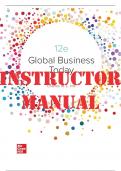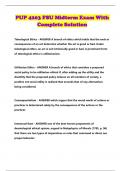,1
Hill, Global Business Today, 12e
Chapter 1 Instructor‘s Manual
Instructor Manual For
Global Business Today, 12th Edition Hill
Chapter 1-17
Chapter 1: Globalization
Table of Contents
Learning Objectives
Chapter Summary
Chapter Opening Activity
Chapter Outline
Opening Case: Detroit Bikes
Introduction
What Is Globalization?
Did You Know Video Clip: Did You Know? Trade Tripled for the United States as a Percentage of
GDP
The Emergence of Global Institutions
Drivers of Globalization
Role of Technological Change
The Changing Demographics of the Global Economy
The Globalization Debate
Managing in the Global Marketplace
End-of-Chapter Resources
Critical Thinking and Discussion Questions
globalEDGE™ Research Task
Closing Case: How the iPhone Is Made: Apple‘s Global Production System
Copyright © 2022 McGraw Hill. All rights reserved. No reproduction or distribution without the prior written consent of McGraw Hill.
,2
Hill, Global Business Today, 12e
Chapter 1 Instructor‘s Manual
Continuous Case Concept
Additional Readings and Sources of Information
Learning Objectives
1-1 Understand what is meant by the term globalization.
1-2 Recognize the main drivers of globalization.
1-3 Describe the changing nature of the global economy.
1-4 Explain the main arguments in the debate over the impact of globalization.
1-5 Understand how the process of globalization is creating opportunities and challenges for
management practice.
Chapter Summary
This opening chapter introduces the reader to the concepts of globalization and international
trade and provides an introduction to the major issues that underlie these topics. The components
of globalization are discussed, along with the drivers of globalization and the role of the General
Agreement on Tariffs and Trade (GATT) and its successor the World Trade Organization
(WTO) in lowering trade barriers. The influence of technological change in facilitating
globalization is also discussed, along with the role of multinational firms in international
business.
The chapter also describes the changing demographics of the global economy, with a special
emphasis on the increasingly important role of developing countries, especially China, in world
trade. This discussion is complemented by a description of the changing world order, which was
brought on by the collapse of communism in Eastern Europe and republics of the former Soviet
Union. The chapter ends with a candid overview of the pros and cons of the trend towards
globalization.
Chapter Opening Activity
Conduct this activity during the first week of class, as an icebreaker.
After students introduce themselves, ask them what their aspirant professional job will be after
graduation. Organize the responses into groups on the whiteboard: accountants, supply chain
managers, ERP managers, business owner or entrepreneur, marketing and sales reps, etc. Then,
ask what additional skills they will need to do those jobs with international customers, suppliers,
and co-workers.
The idea is to help students understand they are unlikely to be successful unless they understand
globalization and develop cultural competencies. Skills they might name include: comfortable
with rapid change; can understand national cultural differences; can work in diverse cultures; can
adapt to diverse management, leadership, and participation styles; can understand differences in
intercultural communication; can build relationships, be a lifelong learner, and others.
Copyright © 2022 McGraw Hill. All rights reserved. No reproduction or distribution without the prior written consent of McGraw Hill.
, 3
Hill, Global Business Today, 12e
Chapter 1 Instructor‘s Manual
Chapter Outline
Detroit Bikes
opening case
Summary
The opening case explores the globalization of the bike industry. In the 1970s, the United States
produced some 15 million bikes every year. Bike 2018 however, about 95 percent of the bikes
sold in the United States were assembled in China. China also produced much of the industry‘s
bike components, leaving U.S. bike companies to focus on design and marketing. In 2013,
Detroit Bikes set out to change this trend and bring bike production back to the United States.
This strategy has proved to be challenging, and even more difficult following Donald Trump‘s
trade war with China which targeted bike parts among other products for hefty tariffs. Detroit
Bikes remains optimistic that its dream of American-made bikes will succeed, but for now, is
pursuing a patchwork of strategic initiatives including importing parts from Vietnam and Taiwan
to Canada, where the bikes would be assembled prior to shipping them to the United States.
Discussion Questions
1. Discuss globalization and how the bike industry epitomizes the phenomenon. How has
globalization, and specifically the globalization of markets and production, changed the nature of
the U.S. industry?
Globalization refers to a world where cultural differences between countries are disappearing,
barriers to cross-border trade and investment are decreasing, communication and technology are
rapidly advancing, and national economies are becoming globally integrated systems. In short,
globalization suggests a more integrated and interdependent world economy. For the U.S. bike
industry, globalization means that much of the industry has moved to Asia, and especially to
China. Nearly every aspect of bike production, from sourcing of parts like tires and seats, to final
assembly, now takes part in China. Indeed, U.S. companies looking to produce their product in
the United States will find it difficult to acquire locally made parts and also labor skilled in bike
production. At the same time, because labor costs are so much lower in China, consumers benefit
from lower prices on imported bike. Paradoxically, this also means that a U.S. company like
Detroit Bikes, that manages to produce its product domestically, will likely be less competitive,
at least on price. Some students might note that because much of the world‘s bike production
takes place in Asia, disruptions to the global supply chain associated with the COVID-19
pandemic have been especially vexing for retailers, producers, and consumers.
2. How has U.S. trade policy impacted Detroit Bikes? What does it mean for consumers? What
does it mean for the workforce at Detroit Bikes?
A country‘s trade policy can often have unintended implications for companies. Bikes and bike
parts were among the many products affected by Donald Trump‘s ongoing trade dispute with
China. And, while the policy was almost certainly not intended to hurt the domestic industry, in
Copyright © 2022 McGraw Hill. All rights reserved. No reproduction or distribution without the prior written consent of McGraw Hill.





